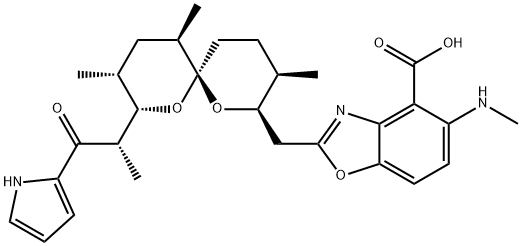| Description | Antibiotic A-23187 (52665-69-7) is a highly selective divalent cation ionophore, commonly used to increase intracellular Ca2+ levels in intact cells (though it is most selective for Mn2+).1 It uncouples oxidative phosphorylation.2 In addition, antibiotic A-23187 inhibits ATPase activity.3 |
| Chemical Properties | white to off-white solid |
| Uses | Calcimycin is a potent calcium ionophore isolated from Streptomyces chartreusis in 1974. Calcimycin is a spiroketal substituted by pyrollic and benzoxazolyl groups which afford its high affinity and selectivity for calcium. Calimycin exhibits broad biological activity against bacteria, fungi and protozoa. It has found wide application as a research tool for calcium-regulated cellular events. |
| Uses | A23187 (Mixed Calcium-Magnesium Salt) is used in cell activation experiments when calcium dose-response data are not required. Ca-Mg ratio ~ 1:1. it is widely used as a compound in cell activation. It is used as a highly selective Ca2+ ionophore. it is used in studies of intracellular Ca2+ mediated events. A23187 has been observed to induce cell activation, differentiation or proliferation. In vitro experimentation has shown A23187 to boost ROS generation and platelet fragmentation. A23187 is a widely used ionophore. It has the ability to increase the intracellular concentrations of cations and is widely used to increase the intracellular levels of calcium. Visualization of Synaptic Ca2+ Calmodulin-Dependent Protein Kinase II Activity in Living Neurons. |
| Uses | CA was used in elucidating the mechanisms underlying the positive and inotropic and chronotropic ability of CA on isolated superfused guinea pig atria. It may also be used to stimulate and measure the erythrocyte Ca2+ dependent K+ channels as the K+ efflux. |
| General Description | A mobile ion-carrier that forms stable complexes with divalent cations. Useful for increasing intracellular Ca2+ levels. Also acts as an uncoupler of oxidative phosphorylation and inhibitor of mitochondrial ATPase activity. An antibiotic with weak activity against Gram-positive bacteria. Also induces apoptosis in mouse lymphoma cell line (S49); however, A23187 has been shown to block apoptosis in other systems, such as when interleukin-3 (IL-3) is withdrawn from IL-3-dependent cells. |
| Biological Activity | Calcium ionophore that induces Ca 2+ -dependent cell death by increasing intracellular calcium concentration. Promotes intracelllular ROS generation and platelet particle formation (fragmentation) in vitro and in vivo . |
| Biochem/physiol Actions | Primary TargetMitochondrial ATPase |
| Purification Methods | It recrystallises from Me2CO as colourless needles. Protect it from light and moisture, store in a refrigerator. It is soluble in Me2SO or EtOH and can be stored for 3 months without loss of activity. The Mg and Ca salts are soluble in organic solvents and cross biological membranes. It has a pKa of 6.9 in 90% Me2SO. The Ca complex crystallises from 50% EtOH as colourless prisms. It is highly TOXIC. [Pressman Ann Rev Biochem 45 501 1976, Chaney et al. J Am Chem Soc 96 1932 1974, Chaney et al. J Antibiotics 29 124 1976, Suzuki et al. Anal Biochem 61 382 1989, Simon & Carafoli Methods Enzymol 56 439 1977.] |
| References | 1) Reed and Lardy (1972) A23187: a divalent cation ionophore; J. Biol. Chem, 247 6970
2) Wong et al. (1973) Effects of antibiotic ionophore, A23187, on oxidative phosphorylation and calcium transport of liver mitochondria; Arch. Biochem. Biophys, 156 578
3) Hara and Kanazawa (1986) Selective inhibition by ionophore A23187 of the enzyme isomerization in the catalytic cycle of sarcoplasmic reticulum Ca2+-ATPase; J. Biol. Chem., 261 16584 |
